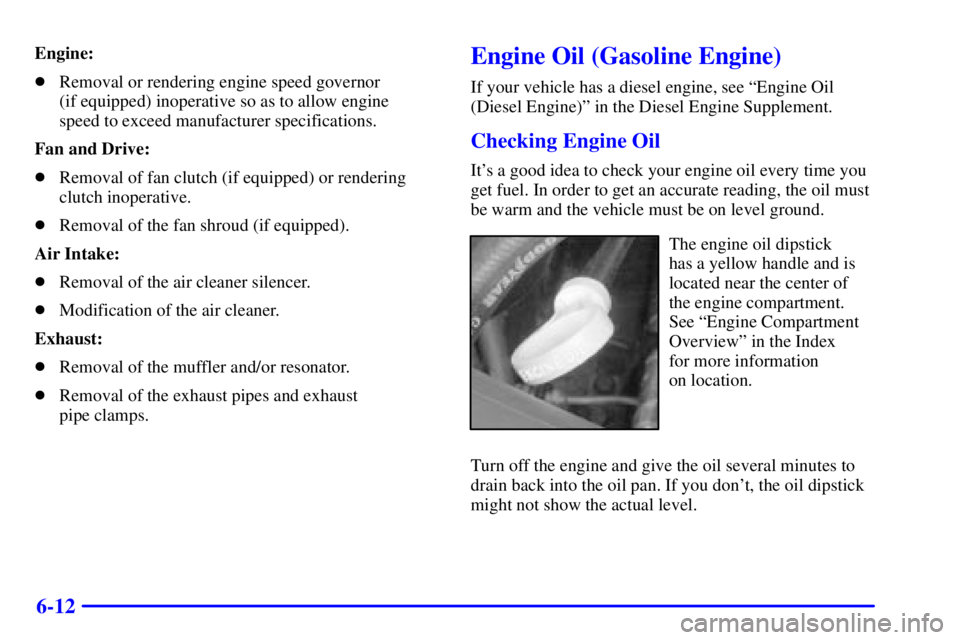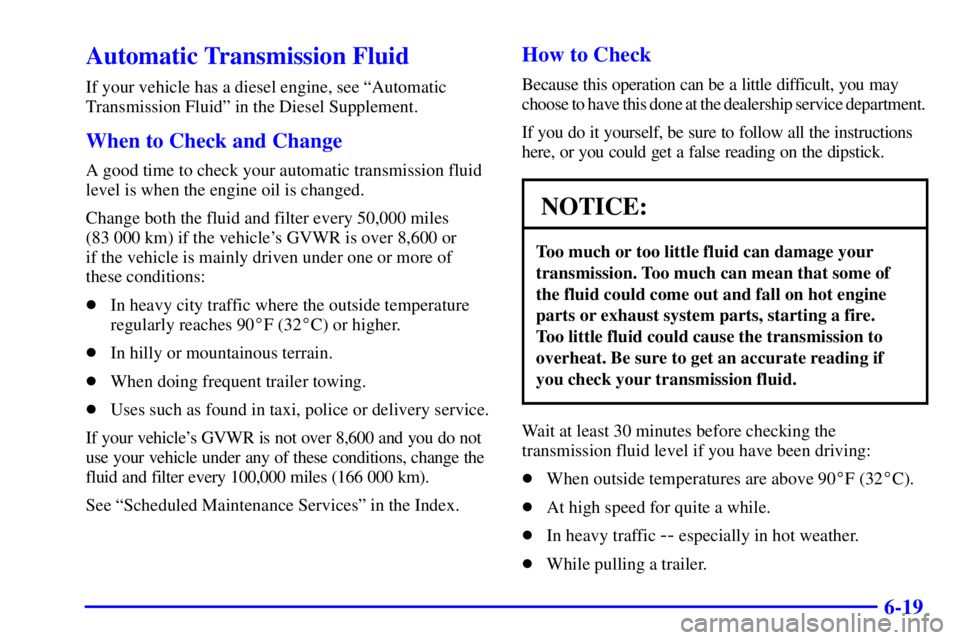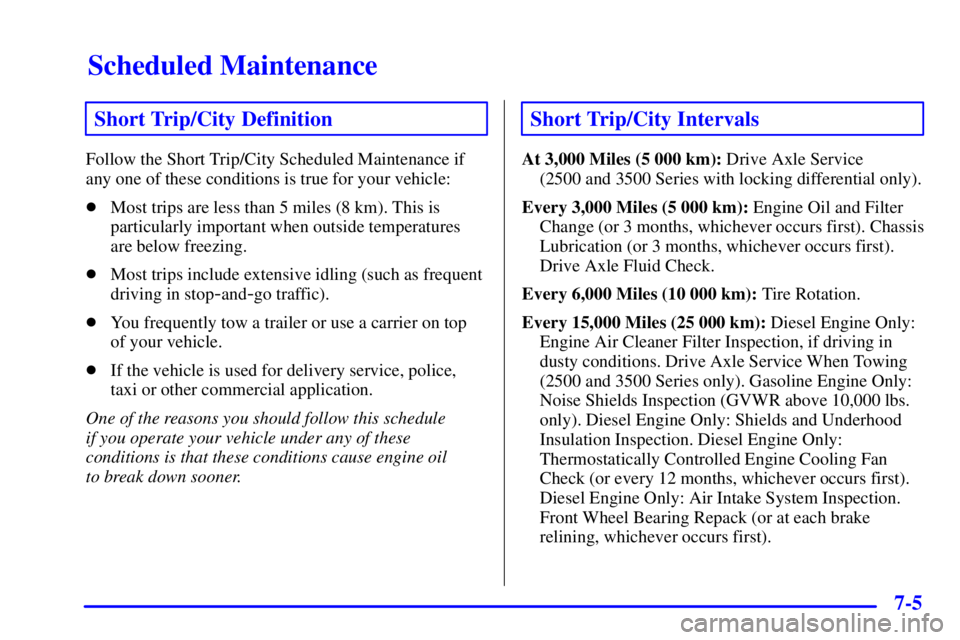Page 275 of 411
6-8
Checking Things Under the Hood
CAUTION:
If your vehicle has air conditioning, the auxiliary
engine fan under the hood can start up and
injure you even when the engine is not running.
Keep hands, clothing and tools away from any
underhood electric fan.
CAUTION:
Things that burn can get on hot engine parts and
start a fire. These include liquids like fuel, oil,
coolant, brake fluid, windshield washer and other
fluids, and plastic or rubber. You or others could
be burned. Be careful not to drop or spill things
that will burn onto a hot engine.
Hood Release
To open the hood, do the following:
1. Pull this handle inside
the vehicle. It is located
in front of the driver's
side door frame near
the floor.
Page 279 of 411

6-12
Engine:
�Removal or rendering engine speed governor
(if equipped) inoperative so as to allow engine
speed to exceed manufacturer specifications.
Fan and Drive:
�Removal of fan clutch (if equipped) or rendering
clutch inoperative.
�Removal of the fan shroud (if equipped).
Air Intake:
�Removal of the air cleaner silencer.
�Modification of the air cleaner.
Exhaust:
�Removal of the muffler and/or resonator.
�Removal of the exhaust pipes and exhaust
pipe clamps.Engine Oil (Gasoline Engine)
If your vehicle has a diesel engine, see ªEngine Oil
(Diesel Engine)º in the Diesel Engine Supplement.
Checking Engine Oil
It's a good idea to check your engine oil every time you
get fuel. In order to get an accurate reading, the oil must
be warm and the vehicle must be on level ground.
The engine oil dipstick
has a yellow handle and is
located near the center of
the engine compartment.
See ªEngine Compartment
Overviewº in the Index
for more information
on location.
Turn off the engine and give the oil several minutes to
drain back into the oil pan. If you don't, the oil dipstick
might not show the actual level.
Page 280 of 411
6-13
Pull out the dipstick and clean it with a paper towel or
cloth, then push it back in all the way. Remove it again,
keeping the tip down, and check the level.
When to Add Engine Oil
If the oil is at or below the ADD mark, then you'll need
to add at least one quart of oil. But you must use the
right kind. This part explains what kind of oil to use. For
engine oil crankcase capacity, see ªCapacities and
Specificationsº in the Index.
NOTICE:
Don't add too much oil. If your engine has so
much oil that the oil level gets above the upper
mark that shows the proper operating range,
your engine could be damaged.
The engine oil filler cap
is located between the
coolant recovery tank and
the engine air cleaner/filter.
See ªEngine Compartment
Overviewº in the Index
for more information
on location.
Be sure to fill it enough to put the level somewhere in
the proper operating range. Push the dipstick all the way
back in when you're through.
Page 286 of 411

6-19
Automatic Transmission Fluid
If your vehicle has a diesel engine, see ªAutomatic
Transmission Fluidº in the Diesel Supplement.
When to Check and Change
A good time to check your automatic transmission fluid
level is when the engine oil is changed.
Change both the fluid and filter every 50,000 miles
(83 000 km) if the vehicle's GVWR is over 8,600 or
if the vehicle is mainly driven under one or more of
these conditions:
�In heavy city traffic where the outside temperature
regularly reaches 90�F (32�C) or higher.
�In hilly or mountainous terrain.
�When doing frequent trailer towing.
�Uses such as found in taxi, police or delivery service.
If your vehicle's GVWR is not over 8,600 and you do not
use your vehicle under any of these conditions, change the
fluid and filter every 100,000 miles (166 000 km).
See ªScheduled Maintenance Servicesº in the Index.
How to Check
Because this operation can be a little difficult, you may
choose to have this done at the dealership service department.
If you do it yourself, be sure to follow all the instructions
here, or you could get a false reading on the dipstick.
NOTICE:
Too much or too little fluid can damage your
transmission. Too much can mean that some of
the fluid could come out and fall on hot engine
parts or exhaust system parts, starting a fire.
Too little fluid could cause the transmission to
overheat. Be sure to get an accurate reading if
you check your transmission fluid.
Wait at least 30 minutes before checking the
transmission fluid level if you have been driving:
�When outside temperatures are above 90�F (32�C).
�At high speed for quite a while.
�In heavy traffic
-- especially in hot weather.
�While pulling a trailer.
Page 337 of 411
6-70 Wheel Nut Torque
MODEL TORQUE
All
140 lb
-ft (190 N´m)
Cooling System Capacity
ENGINE VIN QTY Without Rear Heater QTY With Rear Heater
ªVORTECº 4300 V6 W 11.0 quarts (10.4 L) 14.0 quarts (13.2 L)
ªVORTECº 5000 V8 M 17.0 quarts (16.0 L) 20.0 quarts (18.9 L)
ªVORTECº 5700 V8 R 17.0 quarts (16.0 L) 20.0 quarts (18.9 L)
ªVORTECº 8100 V8 G 23.0 quarts (21.8 L) 26.0 quarts (24.6 L)
After refill, the level MUST be checked as outlined under ªEngine Cooling Systemº in Section 5.
Engine Oil Capacity
ENGINE VIN Quantity
ªVORTECº 4300 V6 W 4.5 quarts (4.3 L)
ªVORTECº 5000 V8 M 5.0 quarts (4.8 L)
ªVORTECº 5700 V8 R 5.0 quarts (4.8 L)
ªVORTECº 8100 V8 G 6.5 quarts (6.15 L)
Page 344 of 411

Scheduled Maintenance
7-5
Short Trip/City Definition
Follow the Short Trip/City Scheduled Maintenance if
any one of these conditions is true for your vehicle:
�Most trips are less than 5 miles (8 km). This is
particularly important when outside temperatures
are below freezing.
�Most trips include extensive idling (such as frequent
driving in stop
-and-go traffic).
�You frequently tow a trailer or use a carrier on top
of your vehicle.
�If the vehicle is used for delivery service, police,
taxi or other commercial application.
One of the reasons you should follow this schedule
if you operate your vehicle under any of these
conditions is that these conditions cause engine oil
to break down sooner.
Short Trip/City Intervals
At 3,000 Miles (5 000 km): Drive Axle Service
(2500 and 3500 Series with locking differential only).
Every 3,000 Miles (5 000 km): Engine Oil and Filter
Change (or 3 months, whichever occurs first). Chassis
Lubrication (or 3 months, whichever occurs first).
Drive Axle Fluid Check.
Every 6,000 Miles (10 000 km): Tire Rotation.
Every 15,000 Miles (25 000 km): Diesel Engine Only:
Engine Air Cleaner Filter Inspection, if driving in
dusty conditions. Drive Axle Service When Towing
(2500 and 3500 Series only). Gasoline Engine Only:
Noise Shields Inspection (GVWR above 10,000 lbs.
only). Diesel Engine Only: Shields and Underhood
Insulation Inspection. Diesel Engine Only:
Thermostatically Controlled Engine Cooling Fan
Check (or every 12 months, whichever occurs first).
Diesel Engine Only: Air Intake System Inspection.
Front Wheel Bearing Repack (or at each brake
relining, whichever occurs first).
Page 346 of 411

Scheduled Maintenance
7-7
Long Trip/Highway Definition
Follow this scheduled maintenance only if none of
the conditions from the Short Trip/City Scheduled
Maintenance are true. Do not use this schedule if the
vehicle is used for trailer towing, driven in a dusty
area or used off paved roads. Use the Short Trip/City
schedule for these conditions.
Driving a vehicle with a fully warmed engine under
highway conditions will cause engine oil to break
down slower.
Long Trip/Highway Intervals
At 7,500 Miles (12 500 km): Drive Axle Service
(2500 and 3500 Series with locking differential only).
Every 7,500 Miles (12 500 km): Engine Oil and Filter
Change (or every 12 months, whichever occurs first).
Chassis Lubrication (or every 12 months, whichever
occurs first). Drive Axle Fluid Check. Tire Rotation.
Every 15,000 Miles (25 000 km): Gasoline Engine
Only: Noise Shields Inspection (GVWR above
10,000 lbs. only). Diesel Engine Only: Shields
and Underhood Insulation Inspection. Diesel Engine
Only: Thermostatically Controlled Engine Cooling
Fan Check (or every 12 months, whichever
occurs first). Diesel Engine Only: Air Intake
System Inspection.
Page 349 of 411
Short Trip/City Scheduled Maintenance
7-10
3,000 Miles (5 000 km)
�Change engine oil and filter (or every 3 months, whichever occurs first).
An Emission Control Service.
�Lubricate chassis components (or every 3 months, whichever occurs first).
(See footnote #.)
�Check axle fluid level and add fluid as needed. 2500 and 3500 Series Only:
If your vehicle has a locking differential, drain fluid and refill at first engine
oil change.
6,000 Miles (10 000 km)
�Change engine oil and filter (or every 3 months, whichever occurs first).
An Emission Control Service.
�Lubricate chassis components (or every 3 months, whichever occurs first).
(See footnote #.)
�Check axle fluid level and add fluid as needed.
�Rotate tires. See ªTire Inspection and Rotationº in the Index for proper
rotation pattern and additional information. (See footnote +.)
ACTUAL
SERVICED BY:MILEAGE
DATE
ACTUAL
SERVICED BY:MILEAGE
DATE